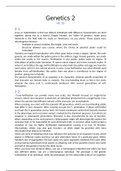Genetics 2
HC 15
2.1
Cross or hybridization is that two distinct individuals with different characteristics are bred
together, giving rise to a hybrid. Gregor Mendel, the father of genetics, made great
footwork in the field with his study on inheritance via pea plants. These plants were
advantageous because:
- Available in several varieties, like height, color and seeds.
- Structure allowed easy crosses where the choice of parental plants could be
controlled.
Gametes are haploid reproductive cells which upon fusion create a zygote. Sperm, the male
gamete, are made within the pollen grains in the anthers. Eggs, female gametes, are made
within the ovules in the ovaries. Fertilization in pea plants: pollen lands on stigma
stimulation of pollen tube formation sperm enters stigma and moves towards ovules
enters it an fertilizes the egg. Self-fertilization is when both the pollen and eggs are from the
same plant, which is the natural process in peas. Cross-fertilization was what Mendel used
besides from self-fertilization; the pollen from one plant is transferred to the stigma of
another, giving rise to hybrids.
The general characteristics of an organism is its characters, whereas specific properties of
that character are termed traits or variants. The true-breeding strain or line is the strain
wherein the same trait is continuously produced after several generations of self-
fertilization.
2.2
Cross-fertilization can provide many new traits, but Mendel focused on single-factor
crosses, where one character is observed; an individual produced from a single-factor cross
where the parents had different variants of the character are monohybrids.
When crossing, you start with the parental (P) generation, which are true-breeding plants
that differ in one character. After crossing you get the F 1 generation, if these self-fertilize
you’ll get the F2 generation and so forth. He found a dominant variant that typically showed
in the phenotype and a recessive variant, masked by the dominant presence, but which can
reappear in subsequent generations. Recessive is also characterized by loss of function,
albeit, depending on the environment a heterozygote might still phenotypically express the
recessive trait, or be responsible for semi-dominant traits. A recessive allele could contain a
mutation or may be highly methylated (epimutation) causing it to lose its function.
Alternatively, alleles may also gain function; an allele might be provided with extra
information that adds to its function.
Genes are units of hereditary that may influence the outcome of an organism’s traits, which
appear in different copies and thus can give alternative forms of a particular gene; alleles.
Mendel’s law of segregation: the two copies of a gene segregate randomly from each other
so that during transmission from parent to offspring, half of the gametes receive one factor
and half of the gametes receive the other factor.
When you have two identical alleles, you are a homozygous individual and when you have
two different alleles, you are a heterozygous individual. The genotype is the genetic
composition of an individual, while the phenotype are the observable traits of an organism.






